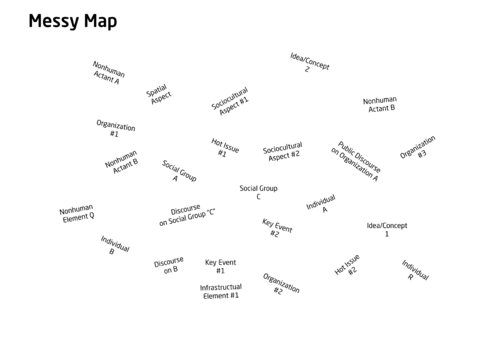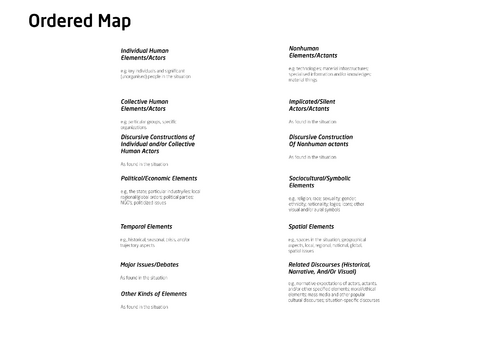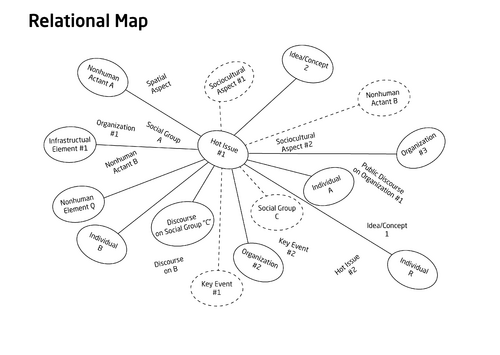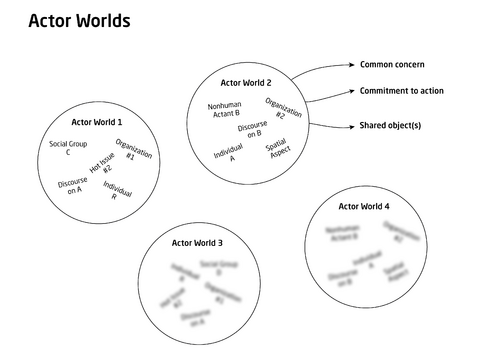Situational mapping
Contents |
Abstract
Whenever a project or program is conducted it is oftentimes with the intention of changing the status quo of the current situation. It is therefore not so irrelevant to know what the situation is and what impact the offered change (a so-called translation) in the status quo will have on the situation. Any given situation consists (for the most parts) of the same elements; human and non-human, material and symbolic/discursive elements as framed by those in it and the analyst [1]. The "human" element is everything human related and can in relation to PPPM best be described as "stakeholders". Knowing stakeholders and their relation to the situation is important but to understand all elements of the situation is even more important. By knowing the other elements of the situation a project/program manager can mitigate even more risks and uncertainties that are dwelling in the complexity of their activities.
Situational mapping is an analytical tool and a prerequisite to another situational analysis tool Development Arena[1], when used can give a better understanding of the situation the project or program is trying to change. Situational mapping consists of three different maps; Messy map, Ordered map and Relation map. The maps are worked can be worked with in a chronological order with the last being the relational map or all three maps can be worked with simultaniously, if the time frame allows for greater abstraction. As one goes through the steps of analyising the situation with the three maps the important aspects becomes clearer and subsequently the different actors "human" or "non human" each with their unique relationship to eachother or maybe the same "common concern", "commitment to action" or "shared objects" will form based on these three into "Actor Worlds"and then eventually they will start to populate the Development Arena.
Situational mapping can be seen as an advanced stakeholder analysis where not only the stakeholders are populating the arena but literally everything else that can have a sizeable impact on the project or program is mapped and accounted for.
Introduction
Situational mapping is a situational analysis tool developed by the American sociologist Adele E. Clarke as an "extension" of another socioligical analysis theory called "Grounded Theory" by Barney Glaser and Anselm Strauss’ (The discovery of grounded theory: strategies for qualitative research. New York: Adline De Gruyter, 1967).
Situational maps - a prerequisite for the Development Arena [2]
Situatinal Mapping Part 1: Messy Map

The messy map is the first part of the situational mapping tool (see fig. 1). With the messy map every conceivable thing related to the situation can be put down in a "messy" kind of fasion.
- The messy map seeks to cover in detail what the given situation entails.
- Who are the main human actors; - individually, social groups, organisations etc.
- What are the nonhuman actors; Technology, Weather, infrastructure, material things
- What are the discourses; discourses within social groups, organisation or even society
- What are the major issues; related to the situation
- What are the sociocultural or symbolic elements; religion, race, gender, sexuality etc.
- What are the spatial elements; geographical aspects, local, regional, national, global etc.
- The messy map can be iterated upon until it feels saturated. From one map-iteration to another, different elements can become obsolete and others can become more important.
Situatinal Mapping Part 2: Ordered Map

The ordered map (see fig. 2) is the second map in the analysis. The ordered map is made using the data from the messy map. The intention with this map is to order the findings in the analysis as the "messy map" can be quite eerie to look at as it expands and become more complex. The way one structe and order the elements from the "messy map" is up to oneself but it might be a good starting point to order them into the categories seen in fig. 2 as one gets acquainted with the methods and the tool. There is however, not an absolute need to have all of these categories in any given situation and one may even have other categories. The goal is not to fill in the blanks, but to instead really examine the given situation thoroughly, and thus making the "Ordered Map" is not an essentiel step to understand the situation and can in some cases be skipped completely and the analyst can move straight to the next map, being the relational map (see fig. 3).
Another and often used approach is the continuos iterative approach where the ordered map serves as the prelimenary map to the "Actor Worlds" where the elements from the "messy map" is directly ordered into spaces of where they belong.
Situatinal Mapping Part 3: Relation Map

The relational map is the third map in the analysis (see fig. 3). When the "messy map" is as saturated as required and picture the situation as a hollistic entity, the anlysist can start to analyse the relation between each element on the "messy map", drawing lines between them and describing "the nature" of that line. The analyst does this systematically one element at a time, using as many "relational maps" as seems useful to diagram through this analytical exercise. In reality, this part of the "situational mapping" is where the majority of the work is done, once it is constructed (ref).
To suit the needs of the analyst the relational analysis can be done very informally and personalised. One might consider to use different style of lines, colours or even symbols (squares, triangles, bolts, hearts, stars etc.) to describe key relationships between one element and another.
Situatinal Mapping Part 4: Actor Worlds - "bridging Situational Mapping and Development Arenas"
To bridge the theory from Situational mapping and Development Arenas, it is necessary to use one of many

Situational mapping as a PPPM tool
Application
Discussion
Although situational mapping can be a useful tool for project, program and portfolio managers, there of course some limitations to consider.
Limitations
- Time and resource-intensive: Situational mapping can be a time and resource-intensive tool for managers to use, because it often requires a significant investment in data collection and the anlysis thereof. This could impose a challenge for many project managers, as they are often under a tight timeline and budget.
- Insufficient generalisability: What is found in the analysis of Situational mapping is often specific to certain context, meaning that it may not be generalisable to other contexts. In truth, this can limit the practicality of the tool for project, program and portfolio managers, as they perhaps work across a variety of projects and contexts.
- Subjectivity: Situational mapping is a qualitive analysis tool relying on the perspective and experiences of individuals. As such is is a subject to bias, and may therefore not provide a completely objective view of the situation.
- Overwhelming amount of data: The amount of data generated of situational mapping can be overwhelming, making it dificult for project, program and portfolio managers to priorities and act upon the most important and relevant findings.
The tools relation to the four core pratices of PPPM: "Purpose, People, Complexity and Ucertainty"
Concluding remarks
To conclude...
Annotated bibliography
- Glaser, B. G., & Strauss, A. L. (1967). The discovery of grounded theory: Strategies for qualitative research. New York, NY: Aldine De Gruyter.
- Jørgensen, U. & Sørensen, O. (2002) Arenas of Development - A Space populated by Actor-Worlds, Artefacts and Surprises
- Clark, A. (2005). Doing Situational Maps and Analysis - Situational Analysis: Grounded Theory after the Postmodern Turn. Thousand Oaks, CA: Sage.
- Clark, A. & Star, S. (2008).The social worlds framework: a theory-methods package . - The New Handbook of Science and Technology Studies
- Clark, A., Washburn, R. & Friese, C (2022). Situational analysis in practice : mapping relationalities across disciplines
References
- ↑ Adele E. Clark (2005).Doing Situational Maps and Analysis. Chapter in "Situational Analysis: Grounded Theory after the Postmodern Turn", Thousands Oak Sage: page 83-144
- ↑ Adele E. Clark (2005).Doing Situational Maps and Analysis. Chapter in "Situational Analysis: Grounded Theory after the Postmodern Turn", Thousands Oak Sage: page 83-144
- ↑ Adele E. Clark (2005).Doing Situational Maps and Analysis. Chapter in "Situational Analysis: Grounded Theory after the Postmodern Turn", Thousands Oak Sage: page 83-144
- ↑ Adele E. Clark (2005).Doing Situational Maps and Analysis. Chapter in "Situational Analysis: Grounded Theory after the Postmodern Turn", Thousands Oak Sage: page 83-144
- ↑ Adele E. Clark (2005).Doing Situational Maps and Analysis. Chapter in "Situational Analysis: Grounded Theory after the Postmodern Turn", Thousands Oak Sage: page 83-144